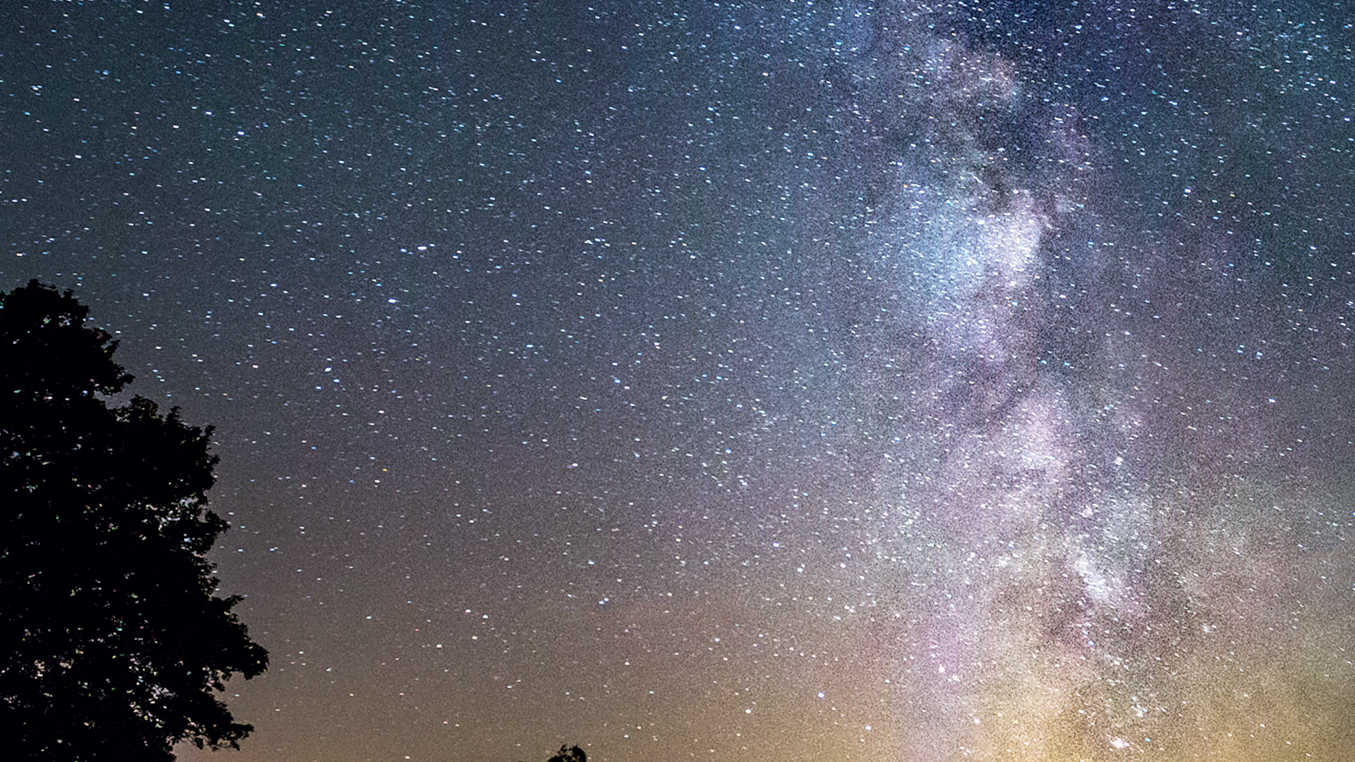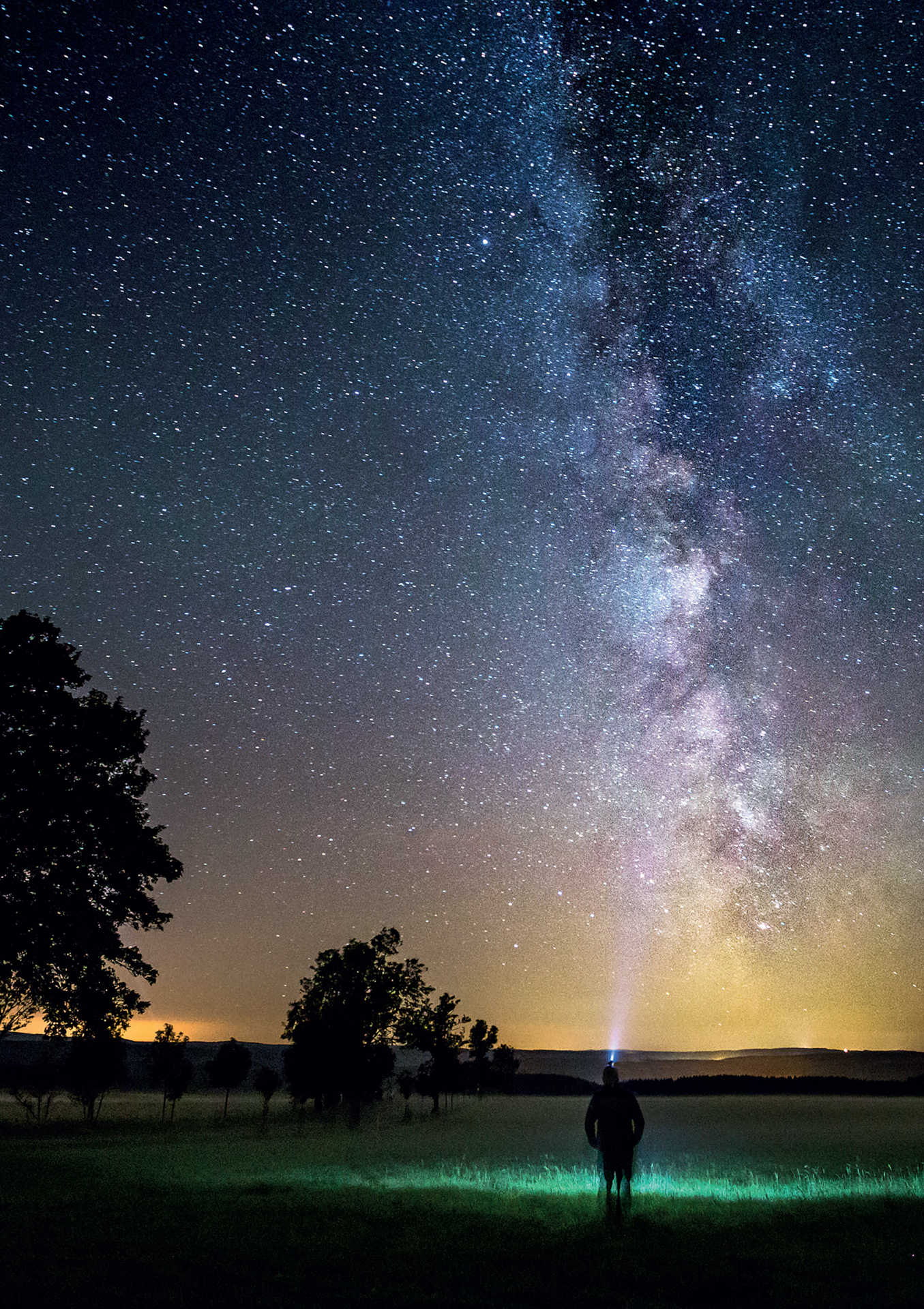The silver celestial band
This destination requires a trip out into the countryside, far away from the city lights. From here, the Milky Way is a real experience.
 Oliver Henze
Oliver HenzeThe summer Milky Way with the naked eye
 Observing the Milky Way is always a spell-binding experience. Towards the centre, it appears especially bright. Oliver Henze
Observing the Milky Way is always a spell-binding experience. Towards the centre, it appears especially bright. Oliver HenzeOne of the greatest wonders of the night sky is visible even with the naked eye: the Milky Way. On a clear and moonless summer night far away from the bright city, its silver ribbon spans the entire firmament. At this time of the year and at our latitudes, it stretches from the constellation of Perseus on the northern horizon to Sagittarius on the southern horizon.
When observed more closely, the Milky Way appears structured: bright, cloud-like dense matter alternates with dark areas. Even if you are only observing it with the naked eye, it will keep you enthralled for hours.
Our cosmic home
From a cosmic point of view, the Milky Way is our home galaxy. It is a collection of several 100 billion stars that together orbit around a central point. Our own Sun is also one of these stars. The four- or five-arm, disc-shaped spiral has a diameter of 100,000 light years and is 3,000 light years deep. The centre bulges to a thickness of 16,000 light years. Our solar system is located in one of the spiral arms about 26,000 light years away from the centre and only about 45 light years above the plane of the galaxy disc. It is estimated that the Milky Way is around 13 billion years old.
Just 6,000 stars
However, of these many billions of stars, we can only see only a tiny portion. Depending on the stars’ brightness, their light only reaches us from distances of a few light years to a few thousand light years. This means that, on a dark and moonless night, approximately 6,000 stars can be seen from all locations on Earth. At a single location it is only around 2,500. The remaining stars are too faint to be seen with the naked eye. Where you look directly along the plane of the disc-shaped galaxy, the stars appear particularly close together in the sky. It is their light that gives us the band of the Milky Way.
 This illustration shows how detailed the Milky Way can be when seen from a very dark location with the naked eye. Markus Dähne
This illustration shows how detailed the Milky Way can be when seen from a very dark location with the naked eye. Markus DähneA spectacular fork
The constellation Cygnus is to be found directly above the observer's head in summer. Here we find a particularly striking part of the summer Milky Way: the so-called Cygnus Star Cloud. The band of the Milky Way forks at Deneb; the western section ends in Ophiuchus, while the eastern part ends in Sagittarius. This fork is also known as the Great Rift. The dark areas are formed by extensive clouds of gas and dust, which obscure the light of the stars behind them. The Great Rift is an impressive sight when observed from a dark location, the contrast between the light and dark areas is very striking.
In the centre of the galaxy
If you follow the Milky Way south, the section found in the constellations Scutum and Sagittarius becomes ever wider and more structured. Bright clouds of stars now dominate the picture. This is where the centre of the galaxy, with the largest density of stars, is located. The brightest area in the constellation of Scutum is known as the Scutum Star Cloud, and in the constellation of Sagittarius it is known as the Sagittarius Star Cloud. As there are fewer dark clouds in these bright areas, the observer feels as though they are looking through a tunnel into distant parts of the very centre of the Milky Way. Our view from the inside of the Milky Way is similar to the view of a galaxy from the outside looking directly at its edge.
 Viewed from the side, our Milky Way resembles a flat disc with a central bulge. Adventures in Astronomy.
Viewed from the side, our Milky Way resembles a flat disc with a central bulge. Adventures in Astronomy.At the edge of the disc
On the northern horizon, in summer the Milky Way ends in the constellation of Perseus. There we are looking more at the outer edge of the galaxy disc. The stellar density is therefore much lower than in the direction of the centre. The Milky Way appears much fainter and narrower in this section.
Practical tip
Get out into the countryside
These days, you have to escape the light pollution of the city to admire the natural spectacle of the Milky Way in all its glory. In or close to a city, the Milky Way is simply outshone by the bright light from street lights, domestic lighting and neon signs. It's worth travelling at least half an hour by car out into the countryside to a location with a clear view of the southern horizon.
Author: Lambert Spix / Licence: Oculum Verlag GmbH
